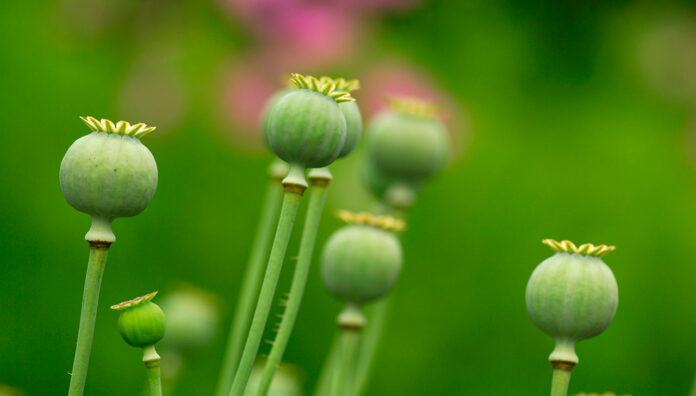Opium has a bad reputation, despite thousands of years of rave reviews.
Although he wasn’t opium’s first fan, Greek physician Pedanius Dioscorides (c. 40–90 CE) was undoubtedly its most cited. As a surgeon to Emperor Nero’s armies, Dioscorides travelled widely, observing the medical uses of plants and other substances derived from animals and minerals. The result was the five-volume De Materia Medica. In it, he refers to sleeping potions prepared from opium and used as surgical anaesthetics. Dioscorides’ pharmacopeia remained the leading medical text until the end of the 17th century.1–3
Well before Dioscorides began his travels, Sumerians were cultivating the opium poppy, Papaver somniferum, in Mesopotamia around 3400 BCE. A Sumerian clay tablet dated to 2100 BCE is considered the oldest list of medical preparations ever discovered. Experts claim it references the opium poppy.4,5
What is opium?
Opium is a narcotic drug found in the unripe seedpods of the opium poppy. Traditionally, the capsule-like seedpod is carefully slit, causing a milky substance to seep out and coagulate on its surface. Exposure to air turns it into a yellow- brown latex – raw opium. Scraped off the pod, the raw opium can be ground into a power, shaped into lumps or bricks, boiled, or treated to release alkaloids such as morphine, codeine and thebaine. Opium and its derivatives are called ‘opiates’.6–8
Rise of the drug industry
As the use of opium, or opium-based products like laudanum, spread globally over the centuries, so too did its reputation as a cure-all. Alone or in combination with other ingredients, it was used for diarrhoea, eye conditions, rheumatism, mental illness, and ‘female complaints’, as well as pain and anxiety.8,9
By the 18th century, quack opiates proliferated. For instance, Dr McMunn’s Elixir of Opium, manufactured by the A. B. & D. Sands drug company, claimed to cure a suite of ailments without being habit-forming. Along with dodgy claims, many such concoctions were linked to addiction, overdose and even death.10,11
Still, the industry powered on, thanks to opium’s genuine painkilling ability. Morphine was isolated from opium in 1804, and heroin was synthesised from morphine in 1898. Both gave a big kick to the pharmaceutical industry and drug abuse.5,8,12
In the 20th century, scientists synthesised opiates like methadone, fentanyl, oxycodone, meperidine (Demerol) and hydrocodone. Along with morphine, they remain central to the treatment of severe and postoperative pain.6,8,12
How it works
Opium and its chemical cousins activate receptors in the brain, spinal cord and peripheral nervous system. There are three major classes of opioid receptors: δ-opioid, κ-opioid and μ-opioid. When activated, they reduce neuronal excitability, inhibiting the release of pain transmitters. Other actions reduce anxiety, increasing relaxation, sleepiness and euphoria. The μ-opioid receptor is critical to addiction due to its link to dopamine release.12,13
Opium down under
Opium is illegal in Australia. Federal and state laws penalise growing, possessing, using and selling opium. But since the 1970s, it’s been legal to cultivate Papaver somniferum for the pharmaceutical and food industries. Today, Australia produces roughly half the world’s legal opiates.4,7,14
References
- Oxford Reference. Pedanius Dioscorides. Oxford University Press.
- University of Chicago. Dioscorides: De Materia Medica.
- Rogers K. Pedanius Dioscorides Greek physician. Britannica.
- Carlin MG, Dean JR, Ames JM. Opium alkaloids in harvested and thermally processed poppy seeds. Front Chem 2020;8:737.
- Norn S, Kruse PR, Kruse E. History of opium poppy and morphine. Dan Medicinhist Arbog 2005;33:171–84.
- Drugs.com. Opium.
- Alcohol and Drug Foundation. Opium. 2021.
- Rogers K. Opium drug. Britannica.
- Aurin M. Chasing the dragon: the cultural metamorphosis of opium in the United States, 1825–1935. Med Anthropol Q 2000;14(3):414–41.
- Odyssey’s Virtual Museum. Dr. McMunn’s elixir of opium bottle. Odyssey Marine Exploration Inc.
- Tareen F, Ayroso VC, Tareen M, et al. Opium. J Hist Dent 2021;69(1)46–55.
- Hamilton GR, Baskett TF. In the arms of Morpheus the development of morphine for postoperative pain relief. Can J Anaesth 2000;47(4):367–74.
- Drugbank Online. Opium. 2022.
- NSW Department of Primary Industries. NSW Poppy Industry.



 Professor Margie Danchin[/caption]
Professor Margie Danchin[/caption]

 Dr Peter Tenni[/caption]
Dr Peter Tenni[/caption]
 How should we deprescribe gabapentinoids, according to the Maudsley Deprescribing Guidelines[/caption]
How should we deprescribe gabapentinoids, according to the Maudsley Deprescribing Guidelines[/caption]



 Pharmacists have always prescribed, but they have the potential to prescribe much more
Pharmacists have always prescribed, but they have the potential to prescribe much more




